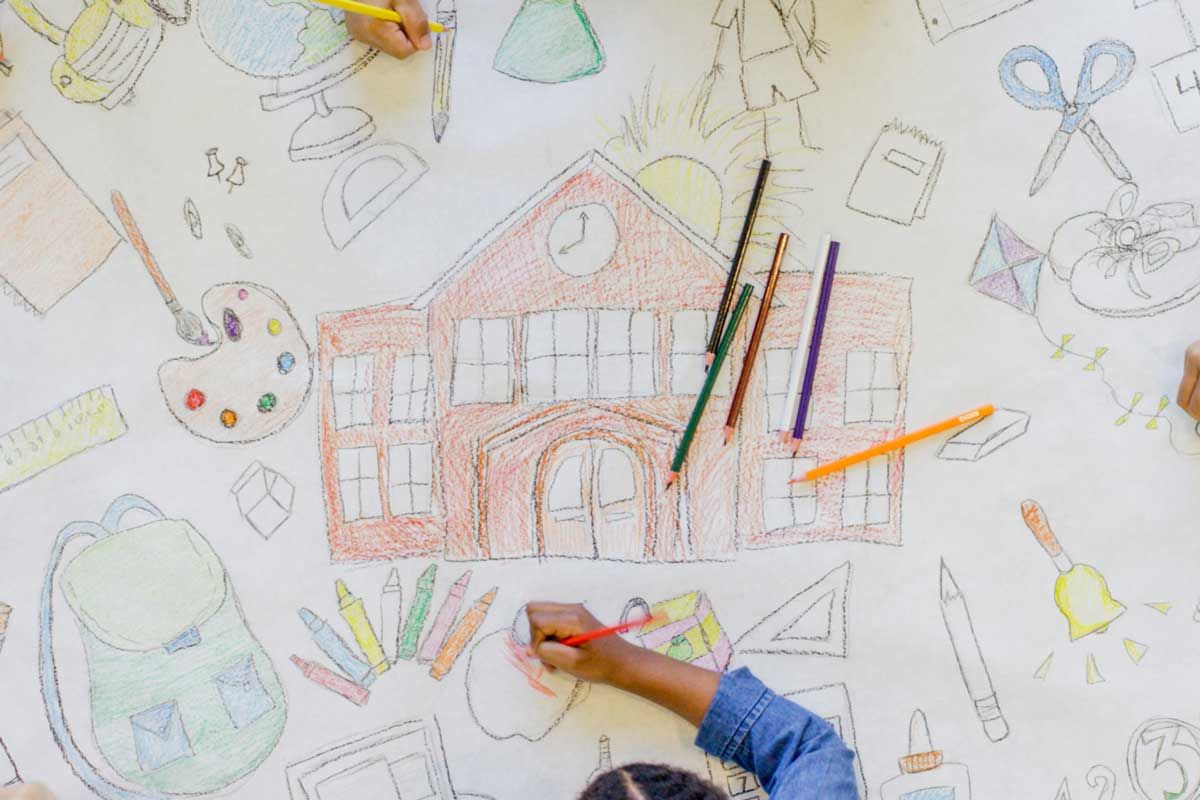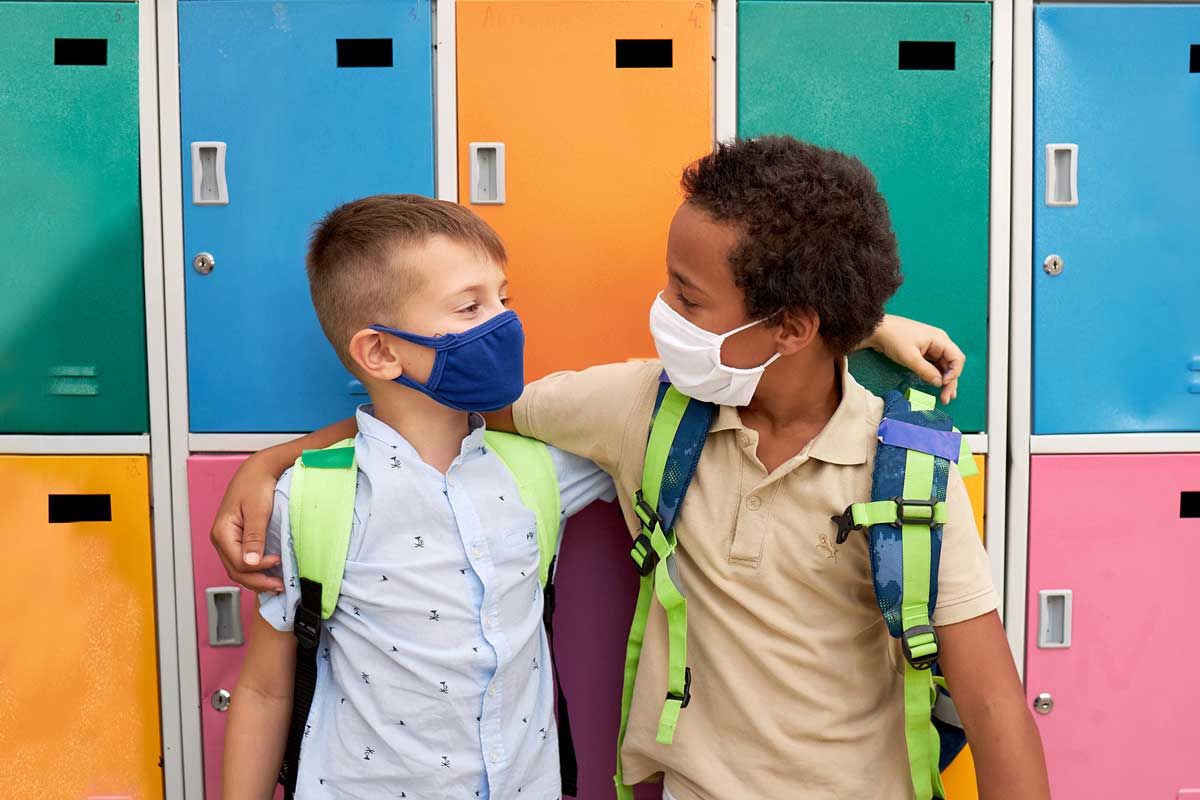
Support Students’ Social-Emotional Needs
Students thrive academically when their social and emotional needs are met. In a study of over 200 school-based, universal Social and Emotional Learning (SEL) programs, participants demonstrated significantly improved social and emotional skills, attitudes, behavior, and academic performance – reflecting an 11 percent gain in achievement – compared to students who did not participate in the SEL programs. [1] In-person public schools are the best resource to support the whole child as students grow and develop.
 Implement Proven Social-Emotional Learning Strategies
Implement Proven Social-Emotional Learning Strategies
Social-emotional learning (SEL) refers to a set of skills – including cooperation, assertiveness, responsibility, empathy and self-control – that students develop to help them learn effectively, overcome challenges and interact with one another in and out of school.
Social-emotional learning: Teaching kids, not content
While the COVID-19 pandemic brought student mental health challenges into clearer focus for the general public, reinventing the wheel isn’t necessarily how to tackle this growing issue ...
Social-emotional learning: Teaching kids, not content
While the COVID-19 pandemic brought student mental health challenges into clearer focus for the general public, reinventing the wheel isn’t necessarily how to tackle this growing issue.
As Frontier Central Teachers Association President and middle school English teacher Amber Chandler explains, social-emotional learning can be as simple as giving students assigned seats so they can re-establish their own relationships with a variety of peers after the disruptions of the pandemic. Or it can be as overt as starting class with a short video about how we apply labels — fairly or unfairly — to each other.
“As part of a unit on how literary characters are developed, we talk about how everybody has stories they tell about themselves and how they view themselves — that’s one label,” says Chandler. “Then we have the kind of label others put on us that may or may not be true. We analyze whether you can reject someone’s label of you. It’s really about facilitating ways for students to talk about their own experience.”
SEL also aids the work of school psychologists, social workers and guidance counselors — where those jobs actually exist and staff isn’t overburdened.
“What we need to do now is open the door a little bit more to have teachers and students feel more comfortable coming to a psychologist or counselor or social worker, even when it’s just a little thing,” East Greenbush Teachers Association member and elementary school psychologist Maureen Singer says.
Yet challenges stand in the way. Future Forward Task Force members reported inadequate professional development, insufficient staffing, and simply not having the time to execute SEL programs.
These challenges must be addressed. Ultimately, the idea behind SEL is that social-emotional learning is as important to the development of children as academic achievement.
“We’re teaching kids, not content,” Chandler says. “If we can’t have relationships with the kids and see them for who they are, they aren’t learning anyway and that will come out on the tests.”
Many schools have implemented SEL practices to meet the expanding needs of students and families and support the transition back to in-person learning, but these practices have not been implemented universally across all districts, nor do all districts have access to resources needed to implement SEL initiatives.
SEL practices are proven to make a difference in the culture of learning in our schools and often result in strengthened community partnerships. For instance, 80 percent of restorative practices – an effective strategy that strengthens relationships between individuals as well as social connections within communities – revolve around community-building activities which reinforce student learning. [2]
It is important to continue these practices beyond the pandemic and include dedicated time for educators and students to learn from and relate with one another.
The beginning of the 2021-22 school year has driven home the need to bolster SEL skills for all students. In particular, violent incidents in some schools have left students, educators and parents alike stressed, burned out and anxious.
 Future Forward Task Force Recommendation
Future Forward Task Force Recommendation
Utilizing statewide and regional resources, including the New York State Education Department's NYS Social Emotional Learning Benchmarks[3] and professional learning resources offered by regional consortia, all schools should develop and implement responsive, schoolwide SEL plans that meet student needs. SEL practices should be woven into day-to-day instructional practice and should provide all school staff with regular professional learning that supports the needs of students and staff.
 Establish and Expand Universal Pre-K, Statewide
Establish and Expand Universal Pre-K, Statewide
The most effective way to prepare children for entering public school is to provide accessible, well-funded Universal Pre-K (UPK) opportunities for communities in every region of the state. UPK is a necessary first step for children entering kindergarten.
“We have many students who come to kindergarten without basic skills, such as eye contact, conversation skills, how to play together, sharing, listening, and basic independence skills like toileting, unpacking a bag, managing tools, sitting in a seat, following simple directions. Literally daily we are getting crying kids out of cars or off buses because they don’t want to come in the building. Then the first hour of the day is spent helping them adjust to being in class. So much of this could be developed in a UPK program.”
~ Adrienne Cohan, Starpoint Teachers Association vice president and elementary school social worker
New York state funds universal prekindergarten programs through a series of grant programs that are allocated annually to school districts. While the law requires school districts to spend a minimum of 10 percent of these funds on community-based organizations (CBOs) to run these programs, often the entire district Pre-K allocation is distributed to such organizations. This means that while the programs are publicly funded, most of the program is not administered by public school districts.
Since the funding is distributed via annually awarded grants, districts do not have an incentive to create capacity within their district to operate these programs.
 Future Forward Task Force Recommendation
Future Forward Task Force Recommendation
The Task Force recommends a consolidation of the UPK grant programs into a modified entitlement program that will automatically provide funding to school districts based upon children served in qualified pre-K programs. State aid formulas work in a similar manner for a variety of programs including BOCES and special education.
 Prioritize Funding to Support Hiring Critical Staff
Prioritize Funding to Support Hiring Critical Staff
Every school needs school psychologists, social workers, counselors, nurses and qualified school-related professionals (i.e., teacher aides, teaching assistants, nurses’ aides) to provide regularly available critical support to all students at all grade levels. Too often, educators report that only secondary students — if any students at all — have access to building-specific counseling services, and younger students are left to share the services of psychologists, nurses and social workers between buildings. Statewide, the average student-to-school counselor is 361:1, 101 students higher than the American School Counselor Association’s recommended 250:1 ratio.[4]
Where school psychologists and social workers are available, their ability to provide direct student services is hampered by crisis management and student assessment demands. This significantly reduces or completely eliminates the time available to meet proactively with students and families.
 Future Forward Task Force Recommendation
Future Forward Task Force Recommendation
Schools must be provided the resources to fully fund counseling and mental health staff to meet the growing needs of students and families and further mitigate the ongoing impact of the COVID-19 pandemic. Programs that support English language learners and special education students must be fully staffed to adequately assist children with increased needs as they return to post-pandemic learning.
To ensure that such staffing is in place, the Task Force recommends enactment of the following state legislation:
- Require schools to employ at least one full-time social worker and at least one licensed school psychologist (S.1969 Jackson/A.5019 González-Rojas)
- Require schools to employ at least one school counselor (S.831 Gounardes/ A.7473 Clark)
- Ensure that all public school districts and boards of cooperative educational services employ at least one registered professional nurse in each school building (S.4782 Jackson/A.666 Cahill)
 Reduce Class Size and Maintain a Complete Curriculum to Support the Whole Child
Reduce Class Size and Maintain a Complete Curriculum to Support the Whole Child
Many schools separated classes into small cohorts of students during the 2020-21 school year to accommodate social distancing requirements. These small class sizes brought on by pandemic-related restrictions helped offset some of the challenges students faced by improving the student to staff ratio and providing more one-on-one attention to students’ needs
The start of the 2021-22 school year brought some much-needed normalcy back to education. However, some pre-pandemic practices, including large class sizes, have returned as well. What’s more, this comes at a time when students’ academic and social-emotional needs are at their highest levels.
What’s been made clear, and what educators and researchers knew long before COVID-19, is that establishing smaller class sizes in all grades is one of the most effective ways to achieve and maintain the highest level of student learning and engagement in our schools. Students in smaller classes perform substantially better by the end of second grade in test scores and grades, and have fewer disciplinary referrals. They are more likely to graduate in four years, more likely to go to college, and more likely to get a degree in a STEM field.[5]
“My own daughter’s reading and math skills are on grade level for the first time in elementary school because she had a fantastic teacher and a class size of 11 during the pandemic. In my classroom, it was a much more intimate experience. I could spend much more time with students figuring out what their weaknesses were in a way I couldn’t always do that consistently when there was 30 of them in the same class.”
~ Jennifer Wolfe, Oceanside Federation of Teachers member and high school social studies teacher
In many cases across the state, pandemic-triggered smaller class sizes were achieved by reassigning library, art, music and PE teachers outside their certification area . This decimated the special area curriculum for kids. The reduction, and in some cases the complete loss of these opportunities for students, has had a lasting impact.
 Future Forward Task Force Recommendation
Future Forward Task Force Recommendation
Diverse learning opportunities — including the arts, library, STEM and physical education classes — help develop the whole child as students grow into young adults. Schools must safeguard these opportunities, even in crisis situations, and commit to providing a well-rounded, complete curriculum for all students.
Additionally, schools should prioritize foundation aid resources to adopt smaller class sizes to improve student engagement and learning. This means prioritizing the hiring of teachers, avoiding the elimination of teaching and teaching assistant positions upon retirements and lowering student-teacher ratios, particularly for grades pre-K—3.





